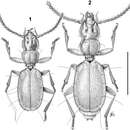Paralovricia: Brief Summary
provided by wikipedia EN
Paralovricia is a genus of ground beetles in the family Carabidae. This genus has a single species, Paralovricia beroni. It is found in Bulgaria.
- license
- cc-by-sa-3.0
- copyright
- Wikipedia authors and editors
Description
provided by Zookeys
Body small (ABL = mm 1.80 - 2.19), elongate, rather flattened, anophthalmous, pubescent, reddish-ferrugineous, with palpi and last tarsomeres paler.
Head relatively large, clypeus separated from the frons by a transverse impression, with two pairs of long thin setae. Frontal furrows ending with round foveae impressed posteriorly, neck distinct; two supraorbital setae not reduced in length. Labrum transverse, with a slight emargination in the middle, bearing six setae. Mandibles slender with a simple apex. Maxillae strongly prominent, penultimate segments of maxillary palpi longer than broad, slightly clavate, terminal palpomeres protracted, needle-shaped and pointed. Mentum without a suture between labium and pre-basilar; labium with a large median tooth. Antennae moniliform. Surface fine, microreticulate, pubescence relatively dense, recumbent, as long as that of pronotum and elytra. Cephalic capsule covered by yellowish, recumbent, relatively long and sparse hairs.
Pronotum subcordiform, hardly explanate sides usually narrowed at posterior angles, with the maximum width at the anterior third. Anterior edge arcuate, with angles entirely rounded. Lateral margin hardly sinuated before rectangular posterior angles. Disc slightly convex, with longitudinal median furrow impressed. Basal transversal furrow deep and conspicuous. Surface with distinct puncturation and long, somewhat sparse, fine erected pubescence. Anterior sixth of their length with pair of marginal setae; basal setae lacking. Scutellum subtriangular.
Elytra longer than their combined width, rounded apically near the suture, wholly covering the abdomen, dorsoventrally slightly convex without a distinct marginal groove. Humeral angles rounded but evident; lateral margins with edges finely denticulate. Sculpture of elytra distinctly microreticulate consisting of wrinkled lines; striae missing; recurrent striola lacking. Elytral disc without discal setiferous punctures, with pubescence relatively dense, recumbent and long, not arranged in rows. Umbilicate series consisting in 9 setiferous pores, with 2nd, 6th and 9th ones bearing a long seta; a geminate pair is made by 5th and 6th pores, with the 5th placed after the 6th one.
Abdominal sterna smooth, with fine and sparse pubescence.
Legs relatively short. Femora robust. Protarsomeres not dilated in the male. Mesotibiae distally expanded outwards and fringed with dense bristles, inner angles with additional spurs. Metafemora smooth. Tarsal claws simple.
Aedeagus with the median lobe stout and poorly arcuate, with a simple narrowly and irregularly sub-squared apex. Basal bulb with the orifice greatly expanded dorsally and delimiting two subequal lateral lobes as inAnillini(Jeannel 1941). Left and right parameres similar to each other, long, widened at the base; narrow, elongated and strongly curved upwards at the apex. One large coaxial seta at the apex and a second one, small, ventral, in a preapical position. Inner sac with a median copulatory sclerite, clew-shaped with two dorsolateral branches.
Female genitalia with the gonocoxite separated from the subgonocoxite (Fig. 11). The latter narrow and elongated, drop-like shaped, totally free from setae or thorns. Gonocoxite stocky, angular and slightly curved, not pointed at the apex; bearing 3 stocky ensiform setae on the external-proximal edge and a dorsal one at the internal edge. The apical part of the gonocoxite shows, at the inner edge, a sensorial dimple bearing two fine and short nematiform setae. Spermatheca ((Fig. 10) short and stocky, membranous, not sclerotized; spermathecal gland not found.
- license
- cc-by-3.0
- copyright
- Pier Mauro Giachino, Borislav Guéorguiev, Dante Vailati
- bibliographic citation
- Giachino P, Guéorguiev B, Vailati D (2011) A new remarkable subterranean beetle of the Rhodopes: Paralovricia gen. n. beroni sp. n. belonging to Lovriciina new subtribe (Coleoptera, Carabidae, Trechinae, Bembidiini) ZooKeys 117: 59–72
- author
- Pier Mauro Giachino
- author
- Borislav Guéorguiev
- author
- Dante Vailati

